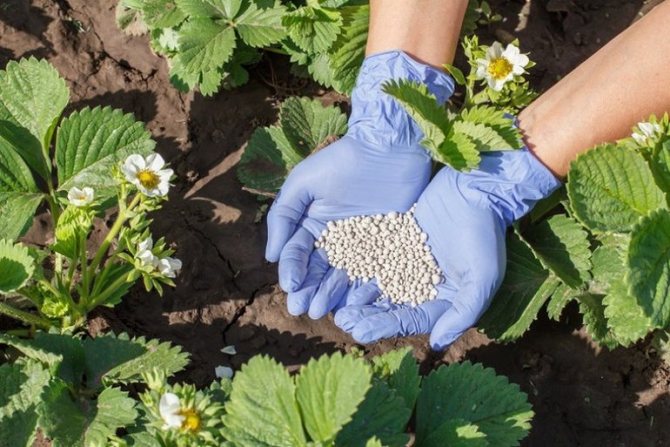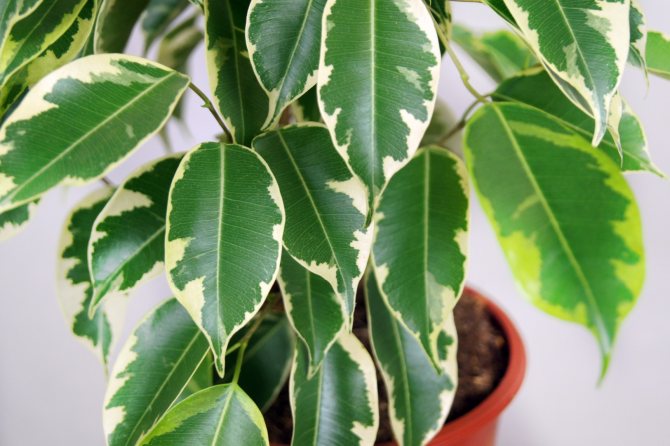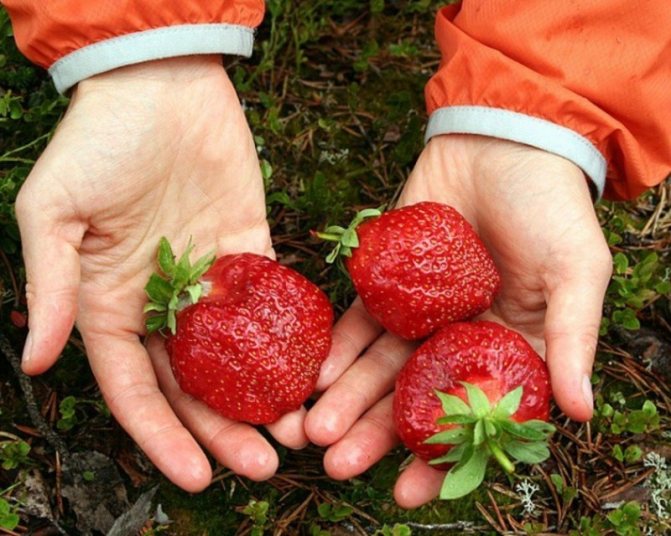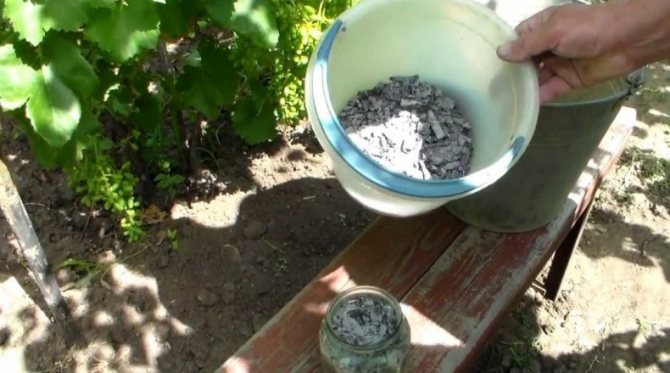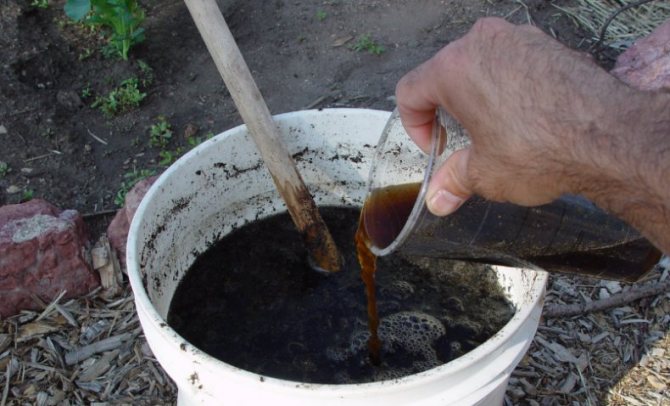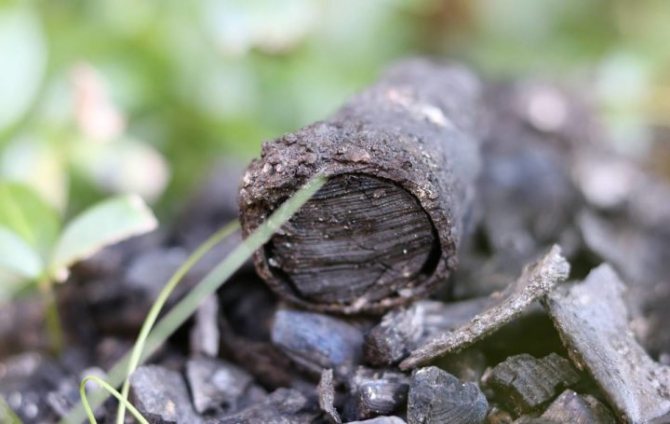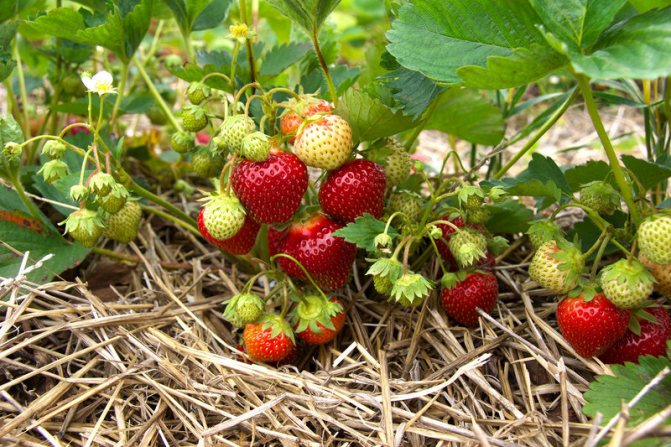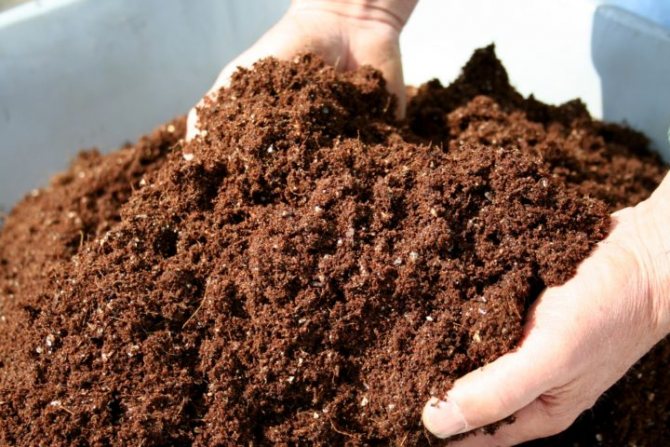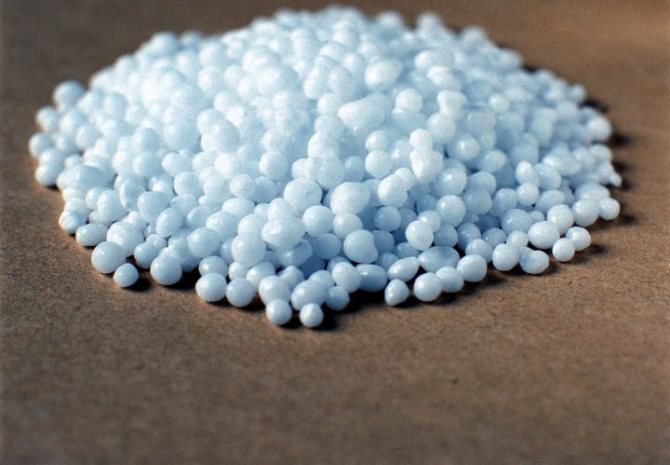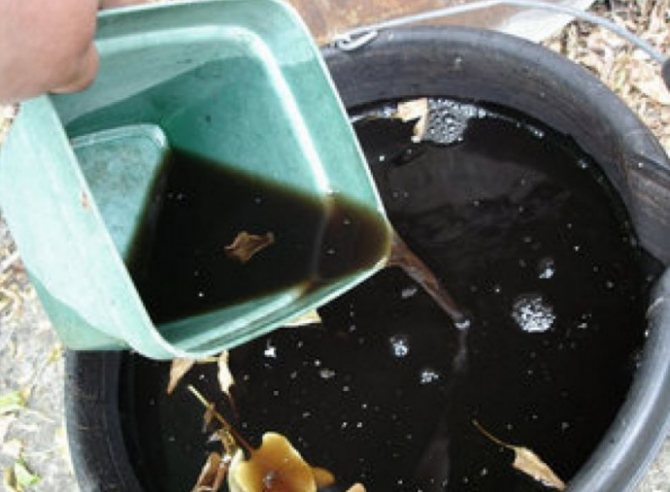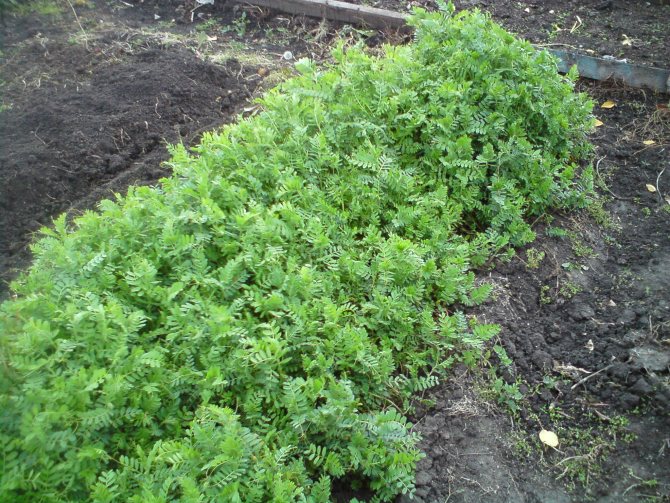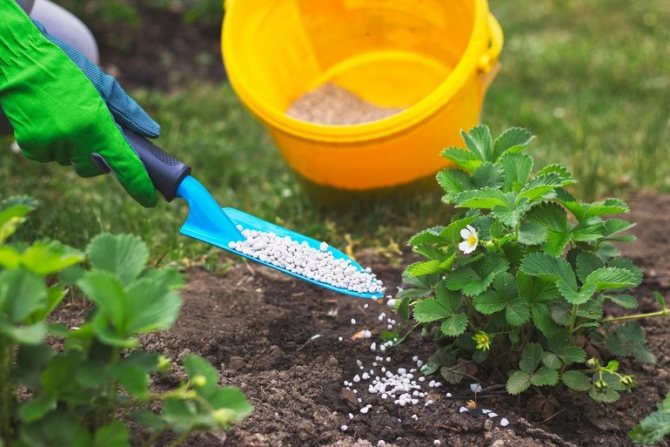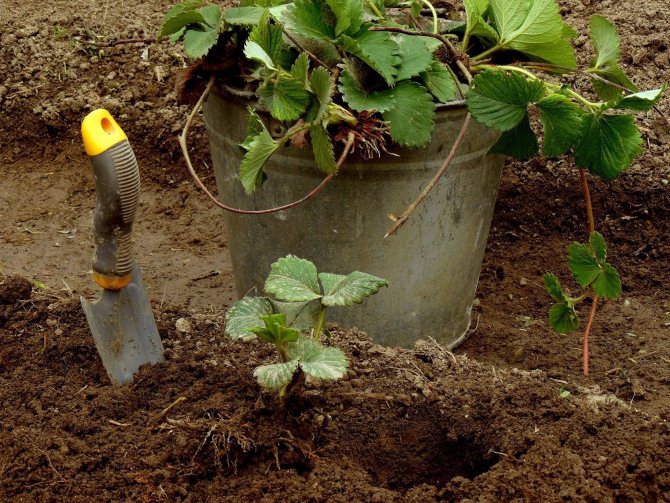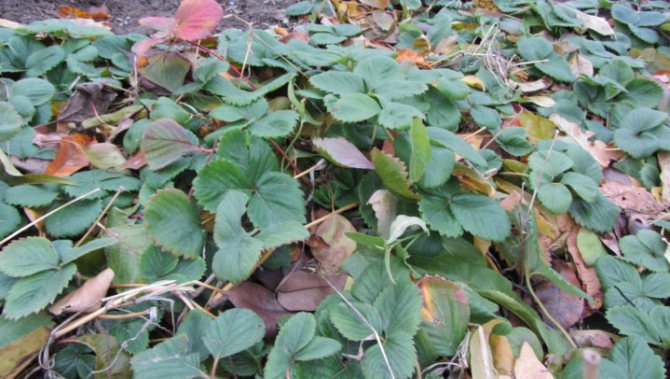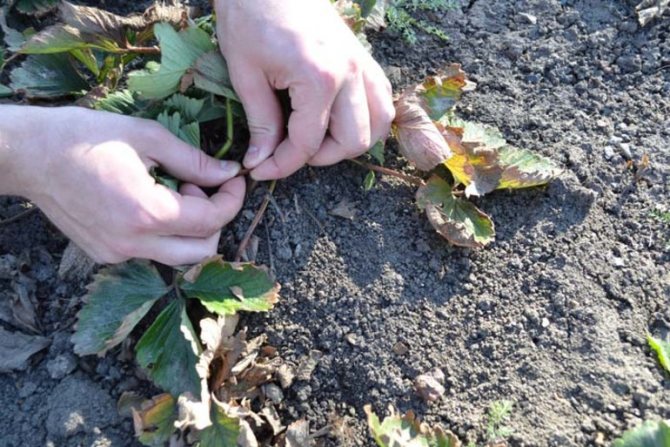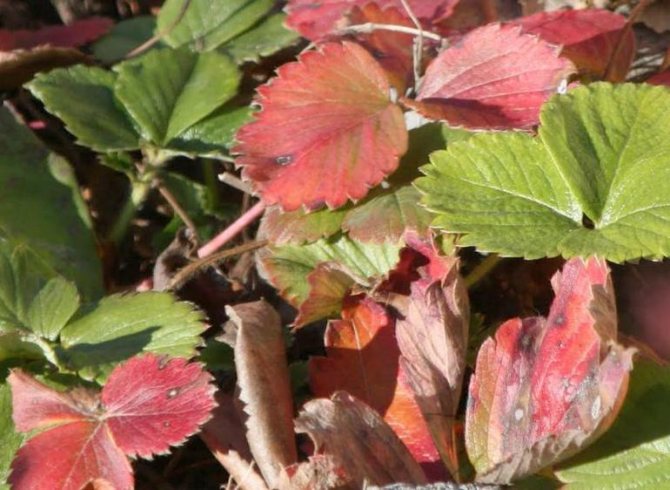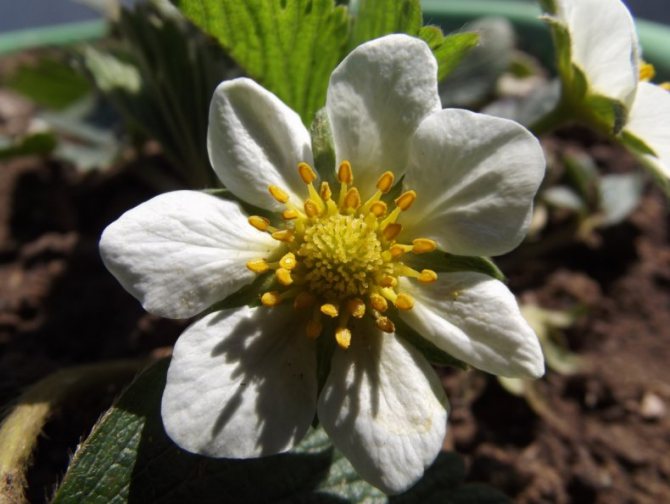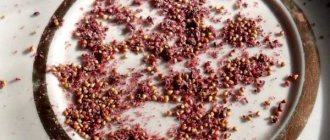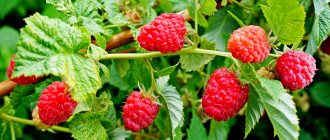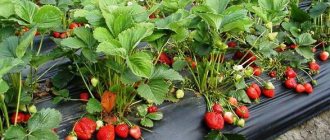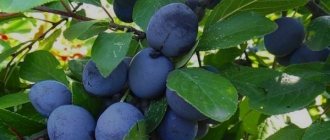Strawberries (garden strawberries), like other perennial crops, require competent and constant care. Some summer residents limit themselves to spring feeding of strawberry plots and, after harvesting, leave without additional nutrition until next year. Such agrotechnical practice does not bring positive results. Fertilizers should be applied regularly throughout the season.
Bird droppings
A real find for the gardener, which, in terms of the content of nutrients, is not inferior to the most popular organic fertilizer - manure. In terms of the speed of influence on the growth and development of vegetable crops, it surpasses some mineral dressings.
It is necessary to carefully add chicken manure to the soil, as its excess can negatively affect the plant.
Chicken droppings are introduced into the soil in the fall by digging after harvest. Also, feeding with poultry droppings is carried out during the period of strawberry growth at the rate of 0.5 kg per 1 liter of water. The resulting solution must be kept under a tightly closed lid for about two weeks.
Organic fertilizers
Organic fertilizers for strawberries can be very different. They need to be selected taking into account a certain type of plant and the climatic conditions in which it grows.
Replacing mullein or chicken droppings with green fertilizers such as nettle tincture. For cooking, a large container is tamped 2/3 with nettles and water is poured to the top, leaving a gap for fermentation. Add slices of stale bread if possible.
After 10 days, dilute the resulting tincture with water 1:10 and apply for root feeding of plants. Fertilizing with nettle absinthe heals the strawberry plantation and gives the berries a sophisticated flavor.
In row spacings, spread out mowed green manure beans (such as lupine), or any grass without seeds, sprinkle with sand or a thin layer of soil.
Yeast is somewhat different from traditional organic matter; it is live unicellular mushrooms. But they are also great for autumn feeding. Yeast contains:
- nitrogen;
- fats;
- proteins;
- carbohydrates.
All these substances are necessary for garden strawberries, both during fruiting and to prepare for hibernation. Yeast infusion brings important micronutrients, B vitamins and phytohormones to strawberries. To prepare the solution, take:
- yeast 100 g;
- warm water 2 liters.
Dissolve yeast in water and add liquid starter culture to a bucket of water (8 L). Wait 5 hours and apply root feed.
Cow or bird droppings
With cow dung or humus, they mulch the row spacings, add to the holes when planting (in the fall, remontant strawberries are transplanted). The substance slowly decomposes, supplying the earth with essential nutrients over a period of 2-3 years.
Cow feces are rich in nitrogen, phosphorus, potassium and calcium. In terms of the composition of useful organic matter, they are much superior to the waste of other pets.
Unlike cow, it is unacceptable to fertilize plants with dry bird droppings! It is a very active substance that can burn the root system and leaves.
To feed garden strawberries, an aqueous extract of bird droppings, at a concentration of 1:30, is suitable. Before use, the liquid is kept for 2 days and poured into the grooves between the rows.With this method of application, the fertilizer gives strength to the plants and regulates the acidity of the soil. But excessive consumption of bird droppings increases the percentage of nitrates, which can adversely affect the quality of the berries.
In the video below, the gardener talks about how to use poultry manure to fertilize garden strawberries:
Mullein
The solution is used for root feeding of horticultural crops. Fertilizer is rich in nitrogen, phosphorus, potassium and calcium. Mullein is well absorbed by plants and has a beneficial effect on the composition of the soil.
To prepare mullein, fresh manure is poured with water in a ratio of 1: 5, mixed thoroughly and kept for 2 weeks in a tightly closed container, stirring once a day. After 2-3 days, after the start of fermentation, the liquid is ready.
Before use, we dilute the fermented mass with water 1:10 and fertilize the plantation. Do not pour more than 1 liter under the bush. Avoid spilling liquid directly on the leafy outlet.
Wood ash
The ash of a burnt-out tree, weeds and branches or stems of sunflowers is an effective micronutrient fertilizer. Ash is sprinkled on the bushes of garden strawberries, and an aqueous infusion is made to nourish the roots.
Recipe:
- ash 1 cup;
- water 10 l.
Apply root dressing with a solution, no more than 0.5 liters per bush. Stir the liquid during use to prevent the ash from precipitating.
Ash is added to the mullein and some solutions of mineral fertilizers, but such mixtures must be made strictly according to the recipe:
- mullein 1 l;
- wood ash 500 g;
- water 10 l.
Pour under the bush, no more than 1 liter per plant.
Wood ash is not only a nutrient, it also has the following effects:
- regulates the acidity of the soil;
- promotes the decomposition of organic fertilizers;
- strengthens plant roots;
- fights against harmful insects and diseases of horticultural crops.
Mulching strawberry beds with dry ash is useful for preventing gray rot and protecting against pests. Do not use ashes from printing products and other household waste to feed plants. The presence of harmful dyes can have a detrimental effect on the health of plants and the quality of berries in the next year.
Sunflower ash, buckwheat or herbal, contains much more potassium than wood ash. Least of all useful elements are found in the ashes of spruce wood and wheat straw.
The following video will discuss the use of ash to fertilize strawberries:
Slurry
The difference between mullein and slurry is the presence of bacterial infections in the latter. To prepare cow dung, dilute with water in a ratio of 1: 8 and leave for 2 days. The method of application is similar to mullein solution.
Organic fertilizers are necessary to stimulate growth and fruiting, but their overdose is detrimental to plants. When growing strawberries on highly fertile soils, organic matter should not be applied in full annually. Water the beds generously after the liquid feed.
Compost
Each area has a special place for composting: it is either a pit or a small area enclosed by a fence. The following ingredients are used to prepare compost:
- vegetable waste without being affected by fungal diseases;
- wood ash;
- manure;
- dry branches and bark of trees;
- paper waste;
- eggshells and cleaning of vegetables and fruits.
This nutritional complex is especially popular for its ease of preparation.
Features of autumn feeding
An important aspect of autumn care is the timing of liquid feeding of the beds. It is advisable to complete feeding with liquid solutions before October. Liquid fertilizers should not be applied if frosts begin soon. Failure to comply with this rule will damage the root system of plants.
For the October feeding of garden strawberries, use only dry mixtures.
The purpose of fertilization in the autumn is to restore and strengthen plants weakened by fruiting and saturation of the soil with nutrients.
Don't overfeed strawberries in the fall. Otherwise, instead of falling asleep for the winter, it will begin to grow again and will die with the onset of cold weather. If for some reason in the fall it was not possible to feed the strawberries on time, postpone fertilization until spring.
2 days after the liquid makeup, mulch the area with sawdust and chopped bark of coniferous trees. Read about strawberry mulching here. Such a measure will scare away harmful insects that are hibernating under the bushes of garden strawberries.
Hydrogen peroxide solution
Hydrogen peroxide for strawberries is used to disinfect and aerate the soil. The solution is a natural fungicide and kills pathogenic bacteria. Peroxide is a safe remedy for treating berries from rotting and spoilage. This product is used in a solution at the rate of 2 tablespoons of peroxide per 1 liter of water.
We process the bushes with a ready-made solution in the morning and evening hours, after exposure, only oxygen and water remain. It is important to carry out the treatment in early autumn - this is an excellent prevention against gray rot.
When to feed strawberries and why is it important?
Experienced gardeners have developed a consistent fertilization schedule for garden strawberries:
- in spring - when the snow melts, before the beginning of the growing season;
- in summer - at the end of fruiting;
- in the fall - until the first frost.
Do not feed the strawberries when the berries have already appeared on them. Otherwise, the crop will taste like fertilized and may acquire toxic properties.
The autumn stage of caring for perennial plants consists of feeding and preparing for winter. It was during this period that the foundations of the future harvest were laid.
Autumn feeding of garden strawberries is performed twice:
- In early September, when the leaves are still green.
- In the second half of October, before the cold snap.
The timing can be slightly adjusted depending on the climate and the variety of berries. The repairing strawberry will give birth in September. You can carry out the first feeding immediately after harvesting the fruits, but always before the onset of cold weather.
Autumn feeding of strawberries has the following effect:
- strengthens bushes that have weakened after abundant fruiting;
- increases the quality of the soil depleted during the season, improves air permeability, which is very important for maintaining moisture;
- stimulates the formation of fruit buds.
Without autumn feeding, the plant will weaken its immunity to diseases, and young shoots may not survive the harsh winter. As a result, the farm will incur unjustified losses.
How to fertilize strawberries?
To feed garden strawberries, the following are used:
- organic compounds;
- minerals;
- combining a mixture of organic matter and minerals;
- complex preparations.
A solution of potassium salt and nitrophoska
To replenish potassium reserves and increase the immunity of strawberries, it is recommended to use a solution of potassium sulfate and nitrophoska. In addition to additional nutrition, this mixture will improve the flavor of the berries and provide resistance to many diseases. Potassium salt is combined with nitrophos to saturate with nitrogen, phosphorus and potassium. Mix 20 grams of potassium salt with 30 grams of nitrophoska and dilute in 10 liters of water. With the resulting composition, we water the sockets under the root, avoiding getting into the center of the plant.
Preparing strawberries for winter
Arrangement of wintering for strawberry plots begins in the summer. In order for the plants to safely survive the cold season and please with a high yield, it is necessary:
- Perform summer and autumn feeding in a timely manner.
- If the weather is dry in September-October, water your garden strawberries 1-2 times a week.
- No later than the beginning of September, free the area from weeds and treat with special herbicides for strawberry beds.Later weeding is not recommended, because the disturbed root system will not be able to recover until frost.
- For remontant varieties, herbicide treatment is not possible during this period, postpone the procedure until the end of berry picking.
- After removing weeds and applying liquid feed, treat the plants with parasite and disease control agents.
- It is better to do full leaf pruning at the beginning of autumn so that the strawberries have time to recover before frost. Later, you should limit yourself to selective removal of old and diseased shoots. Do not leave trimmed parts between the beds, as pests can settle on them.
- Do not cover the strawberries until the first frost. A short-term subzero temperature will harden the plants, and they will more easily endure real frosts. Branches of coniferous trees are ideal for shelter, but fallen leaves or straw can also be used.
- Avoid placing sheeting directly on the beds. Warming with spunbond material or other artificial fabrics requires the construction of a frame.
Preparing garden strawberries for winter is not very difficult and costly, but extremely necessary chores. Spring will come and the berry plantation will immediately begin to grow, bloom and delight you with an abundance of tasty and juicy berries, without delays in recovery.
0
Superphosphate, mullein and wood ash solution
It is important to know the rules and proportions that must be followed when mixing mineral and organic fertilizers. Some combinations are not recommended for use, as the resulting solution may be useless or even harmful to the plant. Components such as a solution of superphosphate, mullein and wood ash cannot be mixed.
Despite the abundance of agrochemicals, many summer residents prefer to use organic fertilizers. They are perfectly absorbed by plants to the full, due to the high content of nutrients necessary for growth and development.
Mineral fertilizers
The simplest way of fertilizing with mineral fertilizers is complex preparations, for example: "Autumn Kemira" or "Tsitovit". Before adding mineral mixtures, carefully read the instructions on the package.
The most essential nutrient components are potassium and nitrogen salts. They are used for dry and liquid fertilization and are certainly combined with watering a strawberry garden.
Potassium
The importance of potash fertilizers for the cultivation of garden strawberries cannot be overestimated. Potassium prolongs the term for the shelf life of berries, makes them sweet and delicious.
A clear sign of a lack of potassium in the soil is the brown ends of the leaves and the unusually acidic fruits of strawberries. For top dressing, potassium salt is dissolved in water 2 g per 1 liter and introduced along the row spacing.
To nourish the roots, take a mixture of 15 g (1 tablespoon) of potassium salt and 20 g of nitrophoska, then dissolve in 10 liters of water. Nitrophoska is a rapidly dissolving chemical compound that includes phosphorus, potassium and nitrogen. The resulting mixture is enough for 10 strawberry bushes.
Watch a video about introducing a complex preparation, which includes potassium, phosphorus and nitrogen:
Nitrogen
To replenish the soil with nitrogen, urea or ammonium nitrate is needed. Nitrogen accelerates berry growth, imparts a rich red color and improves the gastronomic quality of strawberries But, subject to the correct dosage of fertilizer.
Excess nitrogen will lower the sugar content in fruits. The main indicators of nitrogen deficiency are stunted and pale leaves, small fruits, weak plant whiskers. For introduction under the bush, the urea is diluted in proportions of 1 tbsp. l. 10 liters of water, this is enough for 20 strawberry bushes.
A mixed solution is made from industrial and organic fertilizers:
- water 10 l;
- ash 1 tbsp.;
- mullein 1 l;
- superphosphate 2 tbsp. l.
Use for fertilization between rows at the rate of 10 liters per 1 sq. m plot. Combined mixtures are prepared immediately before applying to the soil.
Hydrogen peroxide is also used to fertilize garden strawberries. The extract effectively increases the level of oxygen in the ground air, which helps plants to absorb nutrients. To prepare the solution, take:
- water 1 l;
- hydrogen peroxide (3%) 2 tbsp. l.
Use 200 ml per bush for root dressing.
Mineral fertilizers primarily affect the plants themselves, and do not improve the quality of the soil. In weak and depleted areas, it is recommended to combine mineral fertilizing with organic matter.
Compared to organic fertilizers, mineral fertilizers do not have an unpleasant odor, and they are more convenient to use. But their use requires strict adherence to the recommended standards.
Terms of work
They are conditional. Determined by the strawberry variety. So, a remontant culture, which bears fruit all summer, needs feeding in early autumn, then after 1-1.5 months. The one that begins to bear fruit at the end of summer is fed in October-November.
Traditional varieties begin to fertilize from the middle of summer - after the last berries have been picked. Some gardeners spoil strawberries with fertilizer twice: in July-August and in September.
The exact timing is determined by the climatic characteristics of each specific region. For example, in the south, the berry is fed only in November, in the northern regions (where it can grow) - until October.
Liquid top dressing is allowed to be applied about a month before the autumn frosts.
Top dressing after transplant
Autumn is the best time to transplant remontant strawberries. To make it less painful, the culture needs feeding.
The wrong dosage, the wrong fertilizer, or the lack of it will only harm the strawberries.
For an autumn transplant, compost, completely decomposed manure, potassium chloride, superphosphate are used. The culture is fed by the method of dosed introduction into each well.
Fertilizer dosage per 1 sq. m .:
- Organic (optional) - 3000 g.
- Potassium chloride - 15 g.
- Superphosphate - 35 g.
Even a slight excess of the norm when transplanting strawberries can provoke a powerful burn of the root system and the subsequent death of the plant.
After spreading the fertilizer in the holes, the actual crop transplant, the beds should be well mulched. For this, hay, straw, sawdust and even compost are suitable.
Some gardeners use nitrophosphate when transplanting. 35 g of fertilizer is placed in each prepared well. Sprinkle a little with soil to exclude burns from contact of rhizomes with concentrated granules.
Transplanted bushes of remontant strawberries, well fertilized in the fall, do not require spring feeding. The nutrients should last for 1 year. In addition, she will endure the winter period completely painlessly.
Signs of a lack or excess of minerals in strawberries
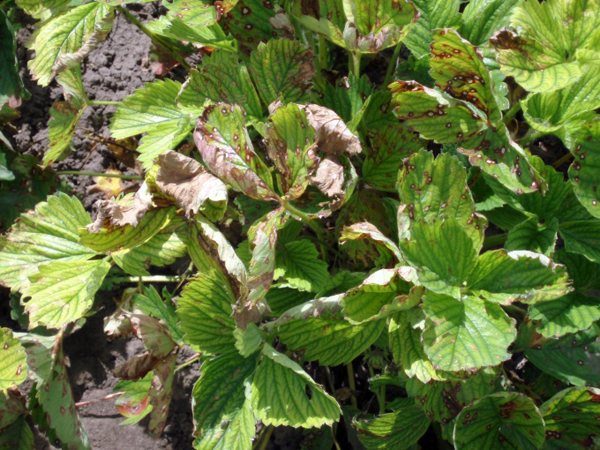
You can find out that this plant lacks some macro or microelements by its foliage - it changes its color. The signs of this deficiency are as follows:
- with a lack of nitrogen in the foliage, the color becomes paler, it can turn yellow, its growth slows down, as a result, it falls off ahead of time. The leaf blades quickly turn yellow, but the veins remain green. But the color of the foliage can turn purple with a reddish tint;
- lack of phosphorus primarily affects ripening berries - they lose their taste, become too soft. And the leaves acquire a dark brown color, which is aggravated in cold dry seasons;
- with a potassium deficiency, the lower leaves of the plant are the first to suffer - the edges of the leaves begin to turn red, over time the color of the entire leaf plate also changes;
- with a calcium deficiency, young leaves do not unfold, their tips begin to darken.
An excess of mineral fertilizers is also harmful and it is expressed in an overly saturated color of leaf plates in strawberries, chlorosis may appear, and the growth of the aboveground and underground parts of the bushes slows down. Yellowing of the edges of the foliage may also occur.
Care and tillage
In addition to autumn dressings, it is necessary to perform a number of works designed to prepare strawberries for winter.
The culture that has completed fruiting is first weeded well, unnecessary mustaches are removed, and treated with special agents for diseases and pests.
Then they start trimming the leaves - by hand, with a pruner or oblique. They do it in August. By removing the leaves, the development of the root system is accelerated. This will not only give strength to the plant, but also have a positive effect on its future fruiting.
Only the leaves should be trimmed, leaving the stems intact where the growing point is.
In parallel with this, the plant is huddled, loosened or dug up the ground between the beds. Then all the plantings are watered and mulched with foliage, sawdust, peat, or even coniferous needles.
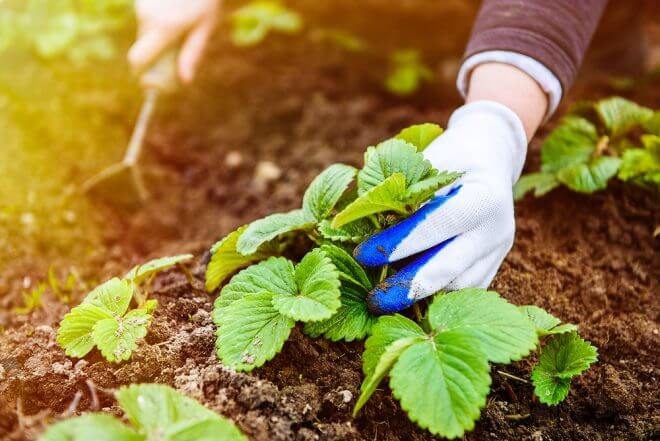

Some gardeners advise not to touch the weeds until spring. There is no longer any harm from them. However, removing them can damage the root system of the plant, which will negatively affect immunity.
In some regions, strawberries are sheltered for the winter, excluding their freezing and further death. This should be done with the onset of frost so that the plants do not start to rot. In regions with massive snow cover in winter, no shelter is needed - the berry is perfectly protected from the cold by an impressive layer of snow.
How to fertilize strawberries in autumn when planting?
If a decision is made to plant strawberries in the fall, the soil must be fertilized so that the young bushes take root faster and survive the cold. The following fertilizers are most effective for these purposes:
- Vermicompost is introduced into the soil 10-15 days before planting. The substance is added dry, after which the site must be carefully dug up.
- Nutrient mineral-organic mixture, consisting of 3 kg of humus or compost, 10 g of potassium chloride and 35 g of superphosphate (all amounts are given per 1 m2). This top dressing can be applied to the hole just before planting. Due to its balanced composition, the mixture not only improves the quality of the soil and contributes to the rapid adaptation of strawberries, but also affects the plant itself, giving it the strength necessary for wintering.
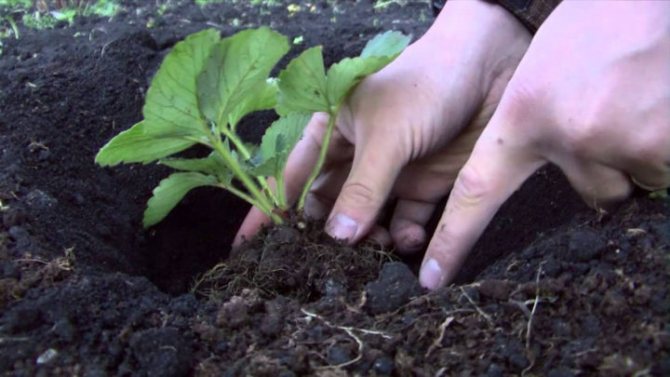

Landing
This amount is usually enough for the entire season, so many gardeners next year do not apply any fertilizing to the ground at all, except perhaps nitrogen-containing ones.
This mixture is used in the future for annual feeding in the fall, but at a lower dosage than for planting.
After fertilization, the soil must be mulched. Most often, compost, peat, sawdust or straw are used for this.
Complex means
Experienced gardeners mix preparations so that there is no excess of chemicals in the soil and fruits. The complex preparations presented in the table are suitable for the plant.
| Structure | Doses | The amount of solution per plant |
|
| 1 liter |
|
| 500 ml |
The easiest way is to purchase ready-made products. They have selected those components that will help the strawberries recover in the fall. They are easy to use and do not have a repulsive odor. Important! You can not overfeed strawberries with the threat of frost, as they will quickly grow and die.
Autumn Kemira
The preparation contains important components for soil and garden strawberries (Se, Zn, P, N, K, B). It is packaged in small bags and looks like a granular powder. The granules are applied dry or a solution is prepared.
For 1 sq. m of soil requires 50 g of the product. It is more economical to prepare a solution from a dry product. For 35 liters of water, take 20 g of the drug and irrigate the plants once a week. It is important that it does not come into contact with the strawberry roots. Autumn Kemira enriches the composition of the soil, promotes the reproduction of beneficial bacteria. It increases resistance to temperature extremes and prevents the accumulation of nitrates in the fruit.
Ruby
Complex preparation Rubin is suitable for indoor and outdoor plants. It prevents black and gray rot, leaf chlorosis. 6.2 g of the product are diluted in 3 liters of water (4 g is placed in a teaspoon).The liquid is sprayed onto the green part of the garden strawberry. The solution is used within 24 hours, then it is unusable.
Hera autumn
Hera Autumn is a preparation with a balanced set of nutrients. The product provides good bud formation and berry wintering. The advantage of the drug is the absence of chlorine and nitrate nitrogen. Hera fall asleep during digging or independently, and then sprinkle with a small layer of earth. For 1 sq. use 30 g of dry matter. It is possible to apply for each piece separately. Put 15 g of the product in the hole.
WMD Autumn
The Autumn remedy from the Buisk plant is suitable for strawberries and other crops. It is made on the basis of lowland peat, contains natural and artificial ingredients. It is brought in in September only dry. It promotes the accumulation of micro and macro elements, accelerates the growth of the suction part of the roots. Before applying, the soil must be sealed. For 1 sq. you need 20-50 g of the substance.
The importance of autumn nutrition
Although strawberries are considered an undemanding plant, generally adapted to the climate of the middle zone, a sufficient yield can be obtained only with high-quality feeding. The type of root system itself determines the importance of different fertilization.
The absence of the main root and a large number of small adventitious roots located in the upper layers contribute to the fact that the bush cannot receive all the necessary nutrients. During the fruiting phase, the strawberry takes all the trace elements from the upper layer, the residues are washed off with water into the lower layer, from where the small roots of the plant practically cannot extract them.
Autumn feeding of strawberries is also important because this plant has two phases of active growth - the leaves grow vigorously in spring and at the end of August at the end of the harvest. Accordingly, by the spring there are practically no nutrients left in the soil, the establishment of vegetative buds may not occur.
If the root system is not strengthened in the fall, in the absence of snow in winter, leaves on the bush may not appear. The lack of nutrients does not have the best effect on the harvest - the berries become small, with wrinkles, the pulp loses juice, the leaves are small, and may turn yellow.
Choosing a place on the site
Well-lit places where beans, beets, carrots, lettuce, garlic, radishes, celery, and dill were growing are ideal for strawberry bushes. But in areas after peppers and potatoes, cabbage and eggplants, it is not recommended to plant strawberries.
Any type of soil can be suitable for this crop, except for wetlands. A slightly larger yield and large berries grow on loam, black soil, sandy loam soils. An ideal harvest can be obtained even on heavy soils by adding peat, humus, manure or ash. It is desirable that the soil has an acidity in the range of 5.5-6.5 pH.


Advice for gardeners
Fertilizers for strawberries when planting - photo
If the first berries at the time of harvest were large, and the subsequent ones, on the contrary, were small, then this means that the plant needs fertilization.


Fertilizers for strawberries - photo
Regularly monitor the condition of the berry bushes, select the right fertilizers, treat the plants with special pest control agents, water them on time, and you can enjoy delicious, juicy berries from your own garden.
Start feeding in the fall
It is important to ensure that the strawberries are placed on fertile substrates for a generous and healthy crop. Not every household plot has such land that is rich in microelements. In many cases, you have to resort to artificial fertilization. This should be done correctly, since the introduction of nutrients in excess will adversely affect the development of the culture.
At first glance, it may seem that strawberries require careful maintenance. In reality, even a beginner can cope with such work. It is important to know four main underlying factors:
- watering;
- top dressing;
- soil care, including cleaning from weeds and loosening;
- fight against diseases and parasites of strawberries.
It turns out that fertilization is one of the most important components of strawberry care. It is feeding that provides a rich harvest. This procedure should not be neglected. Strawberries can exist on their own without requiring outside intervention. But this may not last long, until she reaches the age of two.
In the future, the earth will be depleted, which will begin to manifest externally: the berries will shrink. That is why the regular addition of organic components and minerals is a necessity. Feeding strawberries is carried out three times per season - in spring, summer and autumn. In early September, mineral fertilizers are laid in the substrate so that the bushes have time to recover by the beginning of winter and can survive the frosts without loss.
At the end of the harvest, buds with flower buds form on the branches. Yields in the following season are directly determined by the fertilizing introduced in the fall. If the berry was planted this year, the autumn feeding will be the first for it. That is why it is important to carry it out without disturbance, so as not to harm future bushes. It is noteworthy that fertilizer can increase the yield by 30%.
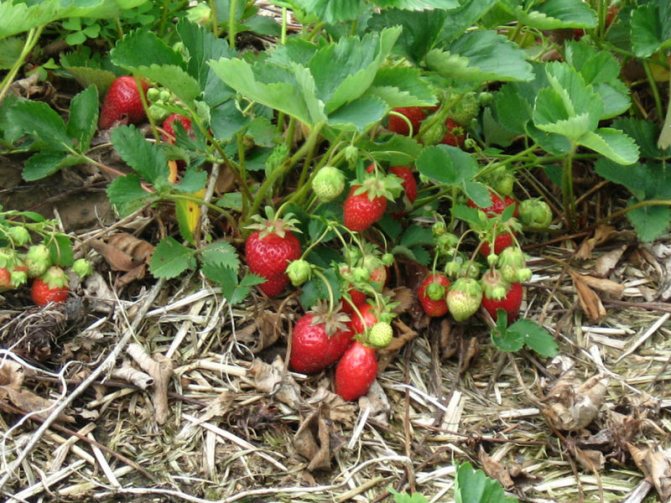

Most often, fertilizers for strawberries are applied in September, but the timing depends on the variety. Certain species require additional nutrient intake in October and November. Be that as it may, you can use fertilizers only when the crop is harvested.
Fertilization dates in autumn
As mentioned above, feeding for strawberries in the fall introduced 2 weeks after the end of fruiting. For different varieties, these are different terms. Repair strawberries yield 2-3 times per season.
Therefore, fertilization is necessary before the second wave of fruiting and after its end. For the harvest, the amount of potassium and phosphorus in the soil is of the greatest importance, so ash and compost can be used from organic matter. From mineral fertilizers - superphosphate and potash fertilizers in liquid form.
Repair strawberry
After harvesting, remontant strawberries are fed 2 times. Nitrogen should not be used in the autumn to allow the plant to calmly prepare for winter. Otherwise, the rapid growth of the bushes will begin. This will greatly weaken the plant. This variety needs potassium in the fall. Both saltpeter and potassium sulfate are suitable. But natural minerals are definitely preferable.
Ash feeding
This natural mineral compound contains many trace elements necessary for remontant strawberries. Ash is successfully used as fertilizer, and bushes are sprinkled with it when planting or transferring to a new place.
Top dressing based on ash is prepared as follows: 1 kg of dry raw materials is poured with a bucket of water and allowed to brew for several days. Before use, the solution is diluted to a light gray shade. Dosage - up to 1 liter per bush.
Wood ash is sprinkled on strawberries at the first signs of decay.
Yeast application
An excellent mineral fertilizer is obtained from ordinary yeast (in their absence, from yeast bread). However, it must be done in advance, since feeding will take a week for fermentation and infusion.
Bread crumbs are soaked in warm water (1 kg per 3 liter jar). Leave for 7 days. During this time, fermentation processes are actively going on. Then the gruel is spread around the roots, sprinkled with soil a little. During fermentation, heat and gases are released, which induce beneficial microorganisms to accelerate their work on the decomposition of organic substances.
If you take raw yeast, then infusion is not required. So, 1 kg of raw materials is dissolved in 5 liters of water.Then the solution is further diluted (1:20) and used to fertilize the plants.
Iodine is the main protector against pests
Iodine protects remontant strawberries from diseases and some pests. It is used as a prophylaxis three times a month. Dosage: 10 drops of iodine are enough for a bucket of water. The culture is thoroughly sprayed with this solution.
Attention! Do not exceed the indicated dosage, as the leaves can get severe burns.


